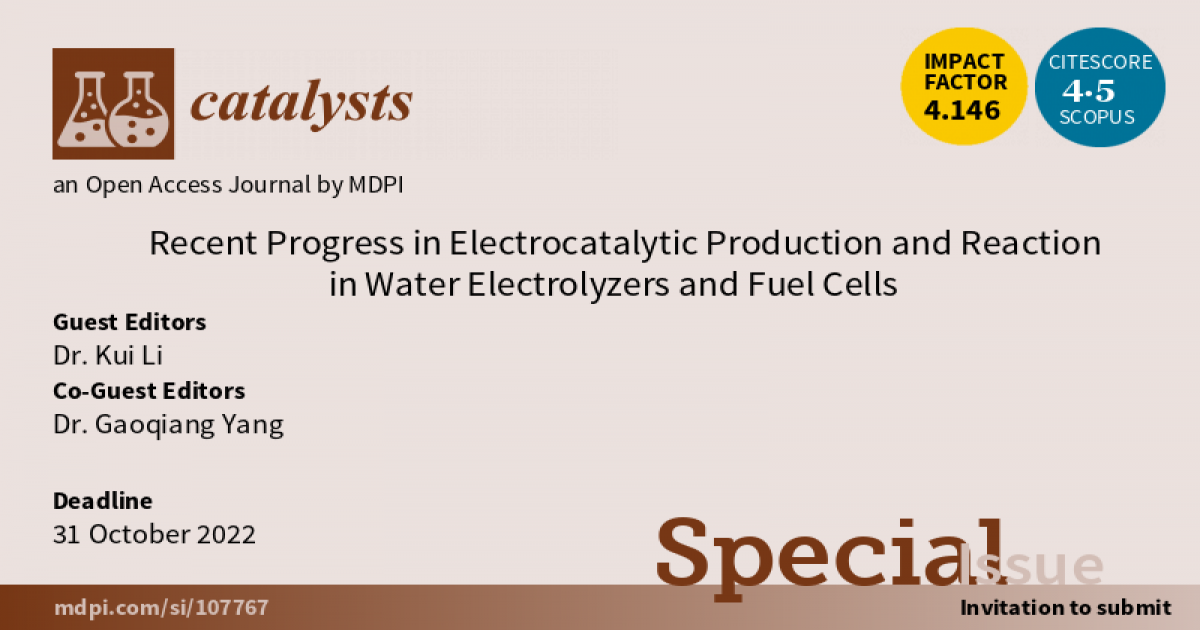- 4.0Impact Factor
- 7.6CiteScore
- 17 daysTime to First Decision
Recent Progress in Electrocatalytic Production and Reaction in Water Electrolyzers and Fuel Cells
This special issue belongs to the section “Electrocatalysis“.
Special Issue Information
Dear Colleagues,
Hydrogen economy is one of the most promising directions regarding the diversification of energy sources and reduced reliance on fossil fuels. The state-of-the-art technologies of renewable energy production and storage have become extremely attractive in the following two reverse vectors. On the one hand, the electricity generated from renewable sources, e.g., biomass, geothermal, solar, tides, hydroelectricity, and wind, could be stored as a clean energy carrier of hydrogen by water electrolysis. On the other hand, the stored hydrogen would be transformed back to electricity through fuel-cell reactions in energy conversion and storage systems.
The aim of this Special Issue on “Recent Progress in Electrocatalytic Production and Reaction in Water Electrolyzers and Fuel cells” is to present state-of-the-art works regarding catalyst preparation and device development in cells. We invite researchers to disseminate studies on electrocatalytic production and reaction in water electrolyzers and fuel cells, including catalyst and support material preparation for hydrogen evolution/oxidation reactions, oxygen evolution/reduction reactions, liquid alcohol oxidation reaction, biomass-derived compounds conversion, CO2 reduction, etc., as well as the investigation of electrocatalytic mechanisms in corresponding fields. Studies pertaining to cell design and device component development for the in situ application in water electrolyzers and fuel cells are also welcome.
Dr. Kui Li
Dr. Gaoqiang Yang
Guest Editors
Manuscript Submission Information
Manuscripts should be submitted online at www.mdpi.com by registering and logging in to this website. Once you are registered, click here to go to the submission form. Manuscripts can be submitted until the deadline. All submissions that pass pre-check are peer-reviewed. Accepted papers will be published continuously in the journal (as soon as accepted) and will be listed together on the special issue website. Research articles, review articles as well as short communications are invited. For planned papers, a title and short abstract (about 250 words) can be sent to the Editorial Office for assessment.
Submitted manuscripts should not have been published previously, nor be under consideration for publication elsewhere (except conference proceedings papers). All manuscripts are thoroughly refereed through a single-blind peer-review process. A guide for authors and other relevant information for submission of manuscripts is available on the Instructions for Authors page. Catalysts is an international peer-reviewed open access monthly journal published by MDPI.
Please visit the Instructions for Authors page before submitting a manuscript. The Article Processing Charge (APC) for publication in this open access journal is 2200 CHF (Swiss Francs). Submitted papers should be well formatted and use good English. Authors may use MDPI's English editing service prior to publication or during author revisions.
Keywords
- electrochemistry and electrocatalysis
- hydrogen evolution/oxidation reactions
- oxygen evolution/reduction reactions
- liquid alcohol oxidation reaction
- biomass-derived compounds conversion
- electrochemical reduction of carbon dioxides
- fuel cells
- water electrolzyers

Benefits of Publishing in a Special Issue
- Ease of navigation: Grouping papers by topic helps scholars navigate broad scope journals more efficiently.
- Greater discoverability: Special Issues support the reach and impact of scientific research. Articles in Special Issues are more discoverable and cited more frequently.
- Expansion of research network: Special Issues facilitate connections among authors, fostering scientific collaborations.
- External promotion: Articles in Special Issues are often promoted through the journal's social media, increasing their visibility.
- e-Book format: Special Issues with more than 10 articles can be published as dedicated e-books, ensuring wide and rapid dissemination.

